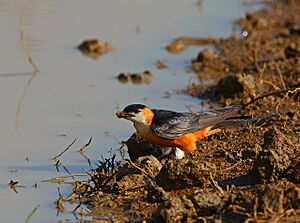Mosque swallow facts for kids
Quick facts for kids Mosque swallow |
|
|---|---|
 |
|
| Conservation status | |
| Scientific classification | |
| Synonyms | |
|
Hirundo senegalensis Linnaeus, 1766 |
The mosque swallow (Cecropis senegalensis) is a big type of swallow. It lives in many parts of sub-Saharan Africa, especially in the west. This bird does not migrate (travel far away for seasons). Instead, it moves a little bit to follow the rain.
Contents
How Scientists Name Animals (Taxonomy)
Scientists give every animal a special two-part name. This helps everyone know exactly which animal they are talking about. In 1766, a Swedish scientist named Carl Linnaeus gave the mosque swallow its first scientific name, Hirundo senegalensis.
Later, scientists learned more about swallows. They found that the mosque swallow and its relatives were a bit different from other Hirundo swallows. So, they moved them to a new group, or genus, called Cecropis. This group was first named by a German scientist, Friedrich Boie, in 1826.
There are three main types, or subspecies, of mosque swallows:
- C.s. senegalensis: Found in places like Mauritania, Senegal, and Gambia.
- C. s. saturatior: Lives in West Africa, from Ghana to Ethiopia.
- C. s. monteiri: Found in southern Africa, from Angola to South Africa.
What the Mosque Swallow Looks Like
The mosque swallow is the biggest and heaviest swallow in Africa. It looks a bit like a large red-rumped swallow. Its head, back, and tail are a shiny dark blue. The sides of its head are whitish, like a collar.
Its lower back (rump) is a dark reddish-brown. The throat and upper chest are a lighter reddish-brown. This color gets darker on the rest of its belly. The feathers under its wings are very light, which stands out against its dark flight feathers.
Female mosque swallows look similar to males. However, their tail feathers are a bit shorter. Young birds are usually browner. These swallows are about 21 to 23 centimeters (8 to 9 inches) long.
Where Mosque Swallows Live (Distribution and Habitat)
You can find the mosque swallow in many parts of Africa. Its range stretches from southern Mauritania and Senegal in the west. It goes east to western South Sudan. Then it moves south to Namibia, northern Botswana, Zimbabwe, Mozambique, and northeastern South Africa.
In southern Africa, these swallows like to live in woodlands. They prefer thick forests with mopane trees and miombo trees. They also like areas with scattered baobab trees and leadwood trees. In West Africa, they prefer open areas like forest clearings and savannas. You can also see them near villages and towns.
How Mosque Swallows Live (Behavior and Ecology)
Mosque swallows eat flying insects. These include ants, termites, and flies. They usually fly between 2 and 30 meters (6.5 to 98 feet) above the ground to find food. They are often drawn to places where termites are flying out of the ground. They also like areas near bushfires. Here, you might see groups of up to 30 birds feeding together.
They fly slowly, almost like a falcon, and often glide. They often hunt high above the trees. Sometimes, they fly with other swallows and swifts.
Reproduction and Life Cycle
Mosque swallows build their nests alone or in small groups. Their nests are made of mud pellets and lined with grass and feathers. The nest looks like a gourd (a type of squash) and has a long tunnel for an entrance.
They often build their nests inside tree holes, especially in baobab trees. They also nest under tree branches, inside buildings, or under road culverts. Mosque swallows can breed all year round. However, they are most active in breeding from August to April. A female usually lays 2 to 4 eggs.



